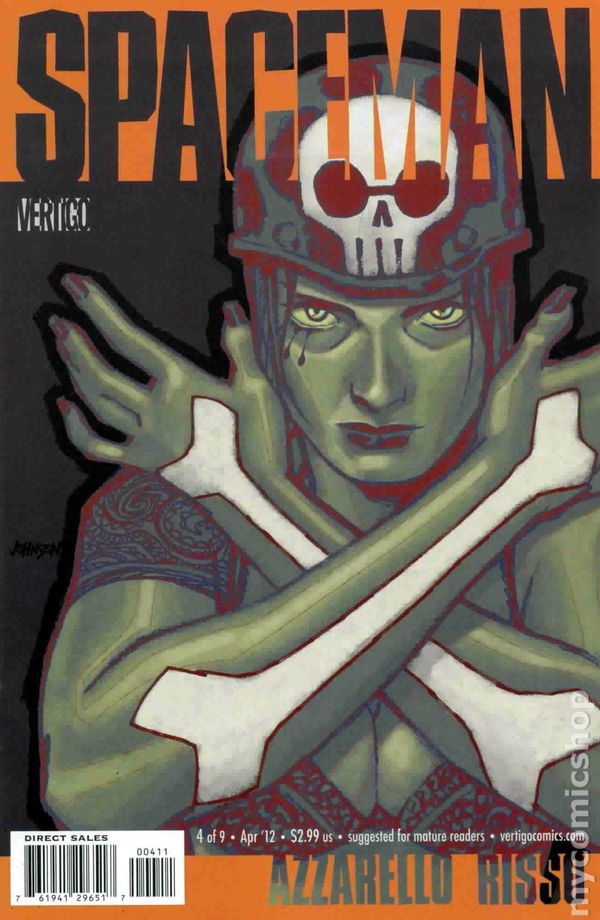Keys to the Kingdom
written by Joe Hill
art by Gabriel Rodriguez
The already stellar
Locke & Key takes a turn for the more adventuresome and ambition in
Keys to the Kingdom. Joe Hill takes greater creative risks in his storytelling style in several of the issues in this collection, and he pulls off every one of them with spectacular aplomb.
"Sparrow," the first in the mini-series and a tribute to
Calvin and Hobbes cartoonist Bill Watterson, is a structural delight: a collection of pages each with four syndication-style panels, which culminate in a mini-climax punch-line of their own. It is, in other words, an exercise in writing a comic book in the style of newspaper comics, and it doesn't miss a beat. Rodriguez does a striking job imitating Watterson's illustration style for Bode's world, in contrast with the style he's already developed for the series in panels told from the perspective of the other characters. The episode's sad and quietly heroic ending proves just how much Hill can do within the considerable restraints he gives himself.
The second of these issues is "Casualties," an issue analogized to classic comic book forms, an imagining of Rufus's world from his perspective.
Locke & Key's Cassandra, able to see the truth—Keyhouse's ghosts and supernatural features as well as Zack's true character, and immune to the Head Key (and perhaps others)—but unable to communicate what he knows to others, Rufus is a delightful voice in the series. His easy interaction with Bode, two boys with difficulty making friends, albeit for very different reasons, is a welcome, if brief, respite from the constant danger posed by Zack and his search for the Omega Key. The titular casualty, however seemingly irrelevant, is actually quite touching, a loss felt as genuinely by the reader as by Rufus.
Keys to the Kingdom also raises the stakes considerably. Zack's assault on the Locke family reaches a fevered pitch even in early issues. His wolf attack in "Sparrow"—complete with the parasitic apparatus, first seen in his ghostly talk with Sam, on his back—is brutal and bloody and clearly fun for him. By the end of "Detectives," Zack has accomplished the unthinkable. Bode, always the heart and innocent center of
Locke & Key and the Locke family, simultaneously its strongest and most vulnerable member, is seriously threatened, forced through the ghost door and re-inhabited by Zack himself.
But just as these events are growing more and more perilous for the Locke children, Tyler Locke is growing into a man capable of battling it. He may be dealing with an angsty break-ups with both his girlfriend and his friend—same incident—and struggling to accept his sister's relationship with another friend Zack, but he also starts showing a lot of maturity in his school work and personal life. Most importantly, however, he quietly and independently starts to suspect Zack of being the Dark Lady, begins systematically piecing together the details of her attacks in an attempt to solve their mystery.
The Keys:
Animal Key, when used with the Animal Door, allows its user to turn into his or her animal counterpart until he or she returns through the door.
Skin Key allows its user to alter his or her racial appearance with the attached mirror until it is changed back using the same key.
Jester Key, when used with the Jester Door, opens a secret closet full of key-related gear and paraphernalia, including the Hercules Necklace, Angel-Wing Harness, and the Music Box.
Angel Key (or Engels-Schlüssel), when used with the Angel-Wing Harness, allows its user to fly.
Hercules Key (or Herkules-Schlüssel), when used in combination with the Hercules Necklace, gives its user superhuman strength and pleasure in employing it.
Philosophoscope Key, when used with the Philosophoscope itself in Keyhouse's observatory, allows its user to discern the truth about a range of people: Best Teacher, Truest Love, Usefullest Soul, Untrustworthy Ally, and Grave Hazard.
Music Box Key, when used with the Music Box, forces those who hear its song to obey the words it sings, controlled by the user of the key.
Collects
Locke & Key: Keys to the Kingdom #1-6: "Sparrow," "White," "February," "Casualties," and "Detectives," Parts I and II
ISBN: 978-1600108860

